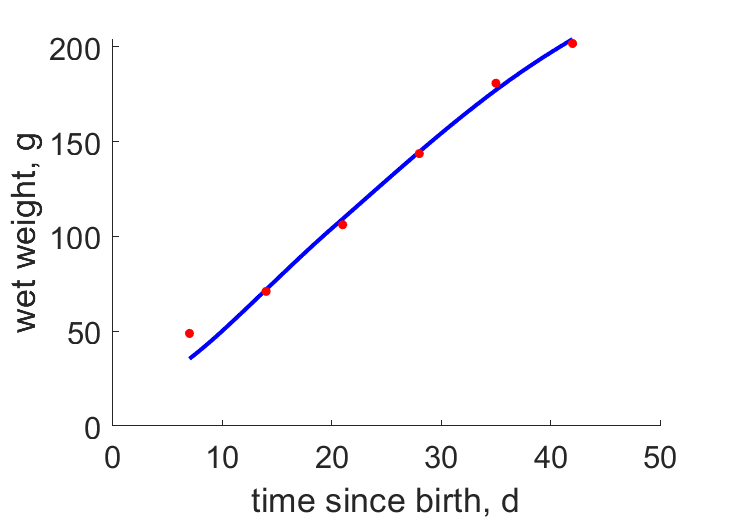Predictions & Data for this entry
| Model: std | climate: Af, Am | migrate: | phylum: |
| COMPLETE = 2.5 | ecozone: TN | food: biHs | class: |
| MRE = 0.038 | habitat: 0iTf, 0iTi | gender: Dg | order: |
| SMSE = 0.003 | embryo: Tnwf | reprod: O | family: |
Zero-variate data
| Data | Observed | Predicted | (RE) | Unit | Description | Reference |
|---|---|---|---|---|---|---|
| ab | 21 | 23.44 | (0.1163) | d | age at birth | avibase |
| tx | 49 | 48.87 | (0.002717) | d | time since birth at fledging | avibase |
| tp | 147 | 136.7 | (0.07005) | d | time since birth at puberty | guess |
| tR | 4365 | 4365 | ( 0) | d | time since birth at 1st brood | avibase |
| am | 1.095e+04 | 1.078e+04 | (0.01553) | d | life span | avibase |
| Ww0 | 14.5 | 13.38 | (0.07698) | g | initial wet weight | avibase |
| Wwb | 10 | 10.17 | (0.01667) | g | wet weight at birth | guess |
| Wwi | 238 | 245 | (0.02931) | g | ultimate wet weight | avibase |
| Ri | 0.004384 | 0.004293 | (0.02055) | #/d | maximum reprod rate | Wiki |
Uni- and bivariate data
| Data | Figure | Independent variable | Dependent variable | (RE) | Reference |
|---|---|---|---|---|---|
| tW |  | time since birth | wet weight | (0.03228) | KainWin2019 |
Pseudo-data at Tref = 20°C
| Data | Generalised animal | Psittacula eupatria | Unit | Description |
|---|---|---|---|---|
| v | 0.02 | 0.03044 | cm/d | energy conductance |
| p_M | 18 | 480.8 | J/d.cm^3 | vol-spec som maint |
| k_J | 0.002 | 0.01994 | 1/d | maturity maint rate coefficient |
| k | 0.3 | 0.3028 | - | maintenance ratio |
| kap | 0.8 | 0.961 | - | allocation fraction to soma |
| kap_G | 0.8 | 0.8022 | - | growth efficiency |
| kap_R | 0.95 | 0.95 | - | reproduction efficiency |
Discussion
- Body temperatures are guessed
- The high age at first reproduction cannot be captured by the std model
- mod_1: Pseudo-data point k is used, rather than k_J; Data set tp and parameter t_R are added, the latter replacing clutch interval t_N. Postnatal T is based on PrinPres1991, see get_T_Aves. See further the revision page, theme puberty
Bibliography